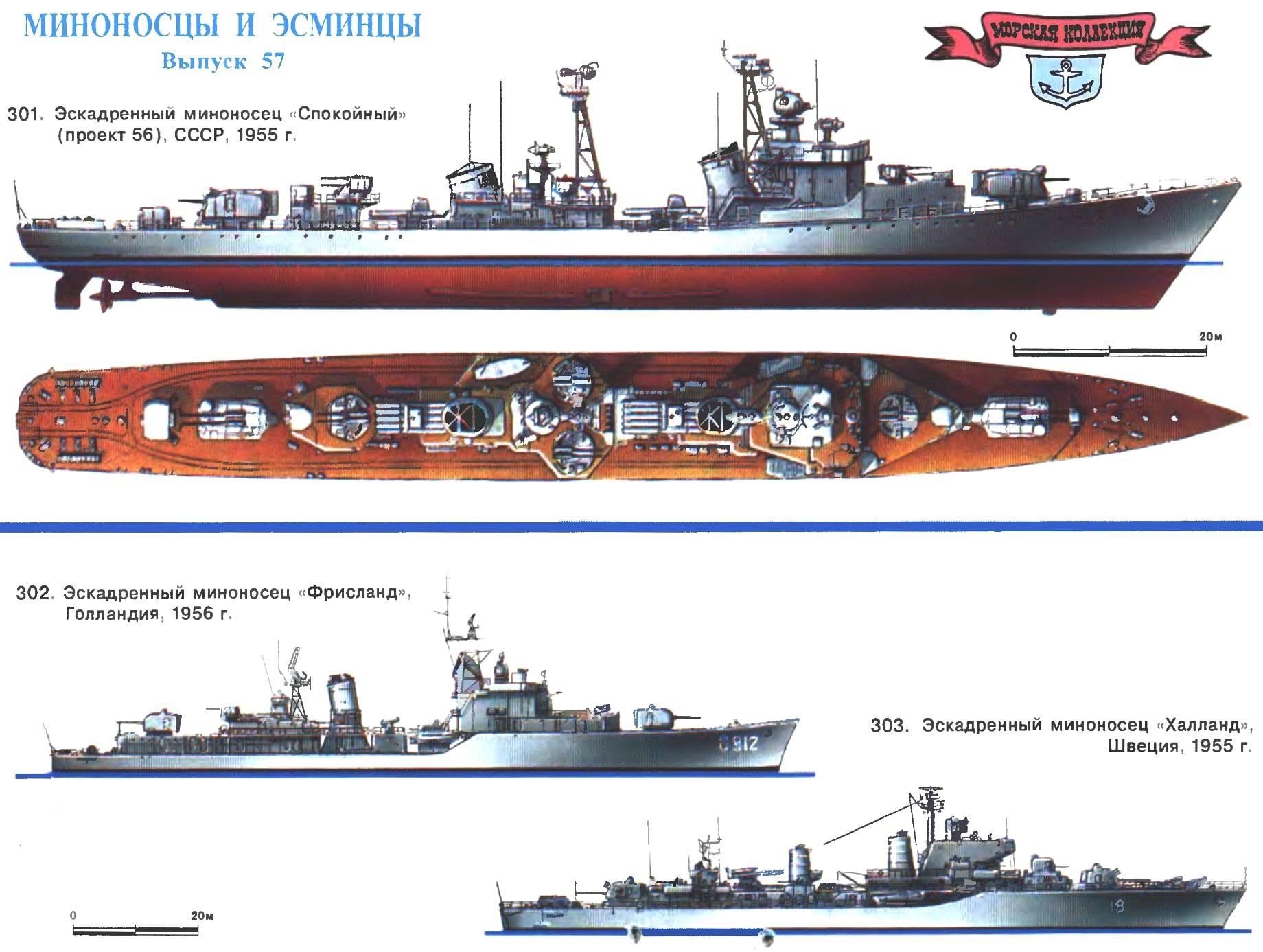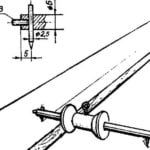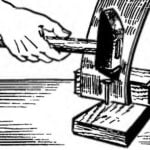Meanwhile, the Soviet warships were inferior to potential enemy in practically all classes. This is true for destroyers. “Thirty-encore”, the representatives of the world’s largest post-war series of destroyers, did not meet modern requirements and was weaker than “hiringof” and “Sumner”. Therefore, in mid-1947 began the development of a fundamentally new project, which would have absorbed the military experience. However, this experience our shipbuilders and naval theorists saw quite differently than Americans.
Project 41, created under the guidance of a renowned shipbuilder, V. A. Nikitin, was a typical leader in the pre-war sense, but included a lot of fundamental innovations. For the first time in the domestic fleet, he had a flush-deck hull with minimum superstructure. Reduced number of Windows: now the convenience of dwelling permanently sacrificed to the anti-nuclear protection. Power plant used high-pressure steam, saves considerable weight and promised to be very economical. But the main innovation was adopted. Two two-gun 130-mm turret systems were completely stable and universal, and in each tower were installed its own radar rangefinder. In addition to local funds, there was a powerful fire control system, including stable command-ranging post, equipped like an artillery radar “Yakor’ -M” and four-meter range finder. Anti-aircraft artillery, originally consisting of coaxial 45-mm guns, after construction has increased significantly as a result of replacement on chetyrekhyadernye installation of the same caliber, the layout reminiscent of the famous German “firingi”. It remains the only torpedo tubes mine rails and traditional. Among other things, “fearless” (the name given to the lead ship of the series, which was supposed to have neither more nor less than 110 units!) can be called one of the most beautiful ships in the history of shipbuilding.
However, it was not without a spoon of tar, and not even one. The disappointment became the driving performance: up to design speed was missing nearly three knots, and the range was less than 10 percent. Overdone and stabilization of artillery. The tower was very large, and the guns they had placed on a single mast, which reduced the overall reliability and reduced accuracy. In addition, the size of the destroyer seemed too large to survive in those difficult years, the construction of a hundreds of “fighters”, in principle, able to fight with any of the American destroyers military buildings.
As has repeatedly happened in our country, from one extreme to the other rushed. Followed the order: we have already started to disassemble the unit, and place 41-year project was ranked 56th (of type “Calm”). He answered almost the same concept, but have a smaller displacement and greater speed. This affected externally, not so noticeable, but very important features: range decreased by almost half, and autonomy — two. In order to accommodate all the equipment had to go back to the more developed add-ons. A few years later it became clear that, at least, one drawback rejected “Fearless” would be his great advantage.
Destroyers of the 56th of the project is clearly not enough room for the extensive upgrades planned in the 60-ies. However, due to the rapid obsolescence and the ships themselves were commissioned only 27 — is more than a hundred according to the original plan.

301. Destroyer “Calm” (project 56), USSR, 1955
It was built at the plant named after A. A. Zhdanov in Leningrad. The standard displacement of 2670 tons, full 3230 T. maximum Length 126 m, width 12,5 m, draft 4.2 m. Capacity twin-shaft turbine installation 72 000 p. C.. speed of 38 knots. Armament: four 130-mm guns, sixteen 45-mm anti-aircraft machine guns, two platetronic 533-mm torpedo tubes, six mortars, two release gear. Only in the years 1955-1957 built 27 units: “Peaceful”, “Bright”, “Brilliant”, “Hastily”, “Experienced”, “Humble”, “Knowledgeable”, “Strong”, “the Calling”, “Clever”, “Secretive”, “Complete”, “Inspirational”, “Conscious”, “Fair”, “Stormy”, “Indignant”, “Noble”, “Invincible”, “Passionate”, “Resourceful”, “Excited”, “Assertive”, “Influential”, “Strong”, “Weathered” and “Brave”. All written off in 1987-1992.
302. Destroyer “Respond”, Holland, 1956.
Built at the shipyard of the Navy in Amsterdam. The standard displacement of 2,500 tons, fully 3070 T. maximum Length 116,0 m, width 11,7 m, draft 5,2 m. Capacity twin-shaft turbine installation of 60,000 p. S., the design speed of 36 knots. Armament: four 120-mm guns, six 40 mm anti-aircraft machine guns, two four-barrelled 375 mm rocket mortar “Bofors”, the two release gear. Just 1956-1958 built eight units: “Respond”, “Groningen”, “Limburg”, “Overijse”, “Drenthe”, “Utrecht”, “Rotterdam” and “Amsterdam”. Six units sold to Peru in 1980, “Respond and Overijse” put at spom in 1979-1982.
303. Destroyer “Halland”, Sweden, 1955
With trails “Gotaverken”. Displacement standard 2630 t, 3400 t full Length the greatest 116,0 m, width 12,6 m, draft 4.6 m. Power dvuhsvetnoe turbine installation 58 000 PS, speed 35 knots. Armament: one launcher for anti-ship missiles Rb-315 Rb-08A, four 120-mm guns, two 57-mm and six 40-mm anti-aircraft guns, and eight 533-mm torpedo tubes, two four-barrelled 375 mm rocket mortar “Bofors”. Just 1955-1956 built two units: “Happend” and “småland”.
It is difficult to evaluate recent Soviet artillery and torpedo destroyers. On the one hand, for the first time managed to build a truly ocean-going ships with high seaworthiness. At the trials in heavy seas and wind at eight points one of the “56-s” developed a full stroke, while the accompanying “top bis” could not squeeze and 15 knots. “Fearless” and “Quiet” is strikingly different from its predecessors in quality of anti-aircraft weapons, the level of energy, ship automation. But, on the other hand, the American “Sherman F.” was much more modern both in concept and in technical parameters of the weapons, tools and, especially, electronic equipment.
Partially the gap was overcome in the course of numerous upgrades, which began in 1958. The twelve destroyers of the type “Quiet” removed one of her torpedo tubes and installed a pair of jet anti-submarine mortars RBU-2500. The remaining apparatus could now be charged as usual, and anti-submarine torpedoes. Even more significant trouble were the nine destroyers in the years 1964-1970: they removed all of the aft group of weapons, installing anti-aircraft missile system “volna” and two of the latest coaxial 30-mm machine gun, as well as a few multi-barreled rocket mortars (project 56K and 56A). So the last “gunners” our fleet became the first missile.
The leaders of the postwar world-the United States and the Soviet Union — tried to be and a minor naval power. Often they were moving the Soviet rather than the American way. In the late 40-ies of Holland, just to get rid of their already burden of colonial possessions, joined NATO and has completely revised its sea policy. One of the most important elements of the program of construction of the new Navy began construction of a large series of destroyers. Their feature was the complete absence of torpedo tubes for the first time in Europe. Hypothetical task of protecting convoys in the North sea from as hypothetical raids of Soviet ships prompted the Dutch to install a very strong artillery. Fully automated 120-mm gun of the Swedish company “Bofors” could produce 45 rounds per gun per minute as a Maritime and air targets and had excellent fire control system, constructed the famous “Philips”. For protection from submarines was tested with various types of weapons the British and American production, but in the end preference was given to the Swedish four-barrelled rocket mortars.
But with a manual installation almost came bobble. At the beginning of design work in 1948 due to the straitened financial conditions it seemed a good idea to use turbines and boilers, prepared before the war for destroyers of the “Isaac svirs”. However, as development was coming to an embodiment and a displacement of beginners all grew and grew, there was a threat that the speed may be limited to only 30 nodes. The engineers did the impossible, and, thanks to the excellent hull shape and relatively small for such large ships turbine allowed to develop on the tests of 40 knots — an excellent result for its time. However, it is worth noting that the Dutch revived the dubious tradition of the early century, when destroyer felt relieved — without weapons, and parts of other equipment.
In any case, mechanisms warehouse only lasted for four ships. So for the next eight destroyers of the type “Friesland” has developed a new turbine on the model of American “Gearing”. The result was achieved on the test almost 43 knots, came close for the French Champions 30-ies of the leaders of the “Le Fantask”. The rest of the second series has retained all the features of its predecessors; grown on a light anti-aircraft armament.
In General, new units of the Dutch Navy was very successful. They not only served more than a quarter of a century, but at the end of his career in his homeland amounted to a significant part of the Navy of a distant Latin American country of Peru. And in the 80-ies of their powerful guns attracted the attention of the density of fire, especially against obviously nedovarennye artillery ships of the new generation. These guns are still in the home fleet: taken from “Gelderland”, they were put as the main fire-missile frigates of the “Tromp”.

304. Destroyer “fearless” (project 41), USSR, 1955
It was built at the plant named after L. A. Zhdanov in Leningrad. Displacement standard, t 3010, full 3830 T. maximum Length 133,83 m, width of 13.57 m, draft of 4.4 m. Capacity twin-shaft turbine installation 100 000 HP, speed 35.5 node. Armament: four 130-mm guns, sixteen 45-mm anti-aircraft machine guns, two platetronic 533-mm torpedo tubes, six mortars, two release gear. In 1974 decommissioned and scrapped.

305. Destroyer”, Kuaida”, Spain, 1960
Built at the shipyard of the Navy in Ferrol. Displacement: 2050 tons standard, full-2770 t, after the adjustment: standard 2580 t, full 3000 t maximum Length of 116.5 m, beam of 11.1 m, draft 3.6 m, Capacity of two-shaft turbine installation of 60,000 HP, a speed of 39 knots. Armament: four 120-mm guns, six 40 mm anti-aircraft machine guns, two rocket mortar “Hedgehog”, two canceller for anti-submarine torpedoes. Only in 1951, consists of three units: “Oquendo”, “Roher de Lauria”, “Marques de La Ensenada”. The last two fully completed due to the changed project. “Oquendo” decommissioned in 1978, the other two in 1982 and 1988, respectively.
Over the years the Dutch destroyers has undergone only minor alterations. So, in 1960, “Utrecht” received eight anti-submarine torpedo tubes caliber 533 mm in the stationary blocks on the sides. However, it was the only real torpedo among its 12 sisterships, besides long. Admirals somehow felt that good with a reliable and tested torpedoes will be enough, and they were removed two years later. Almost at the same time were plans for the replacement of artillery missile weapons, but the main battery still survived.
A good 120 mm guns “Bofors” was in Sweden. Almost simultaneously with the Netherlands, the government ordered two destroyers, which left a noticeable trace in the history of shipbuilding. The Swedes first took a chance to develop and install on your ship weapons, in subsequent years, completely changed perceptions of the war at sea — controlled anti-ship missile. “Halland” is generally distinguished by its set of weapons. In addition to numerous fully automated artillery he carried and the “classics” — two four torpedo tubes (one of them and installed the launcher). Anti-submarine weapons include the powerful “borsovska” mortars, and the destroyer could take mines, and towers at the sides were two guides for flares.
The next series of destroyers entered the system without the shock rockets. Four ships of the type “Ostergotland”, built in 1958-1959, has demonstrated opportunities to further optimize the design of their successful predecessors. The displacement decreased to 2150 so managed to keep most of the combat power, removing only the 57-mm guns and mortars replacing the “Bofors” on the more conservative British “Squid”. Interestingly, in 1963, these ships still have the missile they were armed with anti-aircraft missile complex “sea cat” of English manufacture.
However, not all small fleets post-war Europe the business was as successful as the Dutch and the Swedes. Very instructive example of Spain, which immediately after the Second world war decided to build nine modern destroyers, each armed with eight 105-mm universal guns in paired launchers and seven torpedo tubes. However, the ships have not had time to lay, as the project has been fully processed in accordance with the global “anti” fashion. The torpedo tubes vanished, their place was taken by the release gear and a pair of “Hedgehogs”, and the caliber of the guns was increased to 120 mm, reducing the number of artillery units to three. Thus was born the “Oquendo”— the head ship of the series suffering the latest in the world of the “classic” destroyers. Not only that, the evil Spanish tradition it was built nearly ten years at the first testing it was found that the stability of “Oquendo” literally teetering on the verge of permissible. The ship was sent back to the yard, where loaded the ballast and cut off part of the add-ons. The result: displacement increased by more than 500 tons, and the period of construction has reached 12 years. Moreover, had much to weaken the weapons, removing a couple of 120-millimetrovogo and all 20-mm guns. Not surprisingly, the other two are already launched destroyer was subjected to complete restructuring by increasing the length to 3 and width 2 m. “Roher de Lauria and marqués de La Ensenada” can safely lay claim to the unenviable role of Champions protracted. Only 16 years later after laying the first of them was launched, and after another two years he finally came into operation. In the final version its armament consisted of six already hopelessly outdated American 127-mm guns of the Second world war and the same number of 320-mm anti-submarine torpedo tubes, with the pair of 533-mm tubes for antisubmarine torpedoes. In General, it’s a slightly upgraded “A. Sumner” reduced to 28 knots speed (due to complications with equally ancient boilers). It is not surprising that the “Lauria” served only 12 years in one and a half times less than it was built.
In General, the latest high-speed ships with mainly artillery weapons, according to the tradition, still called the destroyers (although some of them did not carry torpedo armament from the beginning, and others have lost it during upgrades), showed a dramatically increased ability of the post-war shipbuilding. Armed with a powerful automatic artillery, seaworthy, high level of reliability and survivability, they represented a truly multi-purpose ships, though, and was quickly outmatched by their successors of the next generation. But a common opinion that they could not in 60-e and 70-e years to be in a battle competition to their missile counterparts, this is only an assumption, not a proven fact.
V. KOFMAN
 If the Americans and their old and new allies after the Second world war almost completely switched light power their fleets on the task of escort and anti-submarine warfare, the Soviet fleet was absolutely other problems. With the beginning of the cold war, the Soviet Union, in fact, was in the position in which two decades ago was Japan. The only difference is that the industrial strength of our country in the late 40-ies was significantly greater, and political and economic interests associated with marine problems much less. However, because Stalin was going to continue its policy of challenging the world domination of the United States, the development of the Navy was deemed necessary. And the way this development (with the obvious and undeniable initial superiority of the United States at sea) remained the same as that at the time chosen by the Japanese: the creation of individually more powerful combat ships than those built in the West. And to do this was becoming typical of our government in a big way.
If the Americans and their old and new allies after the Second world war almost completely switched light power their fleets on the task of escort and anti-submarine warfare, the Soviet fleet was absolutely other problems. With the beginning of the cold war, the Soviet Union, in fact, was in the position in which two decades ago was Japan. The only difference is that the industrial strength of our country in the late 40-ies was significantly greater, and political and economic interests associated with marine problems much less. However, because Stalin was going to continue its policy of challenging the world domination of the United States, the development of the Navy was deemed necessary. And the way this development (with the obvious and undeniable initial superiority of the United States at sea) remained the same as that at the time chosen by the Japanese: the creation of individually more powerful combat ships than those built in the West. And to do this was becoming typical of our government in a big way.





